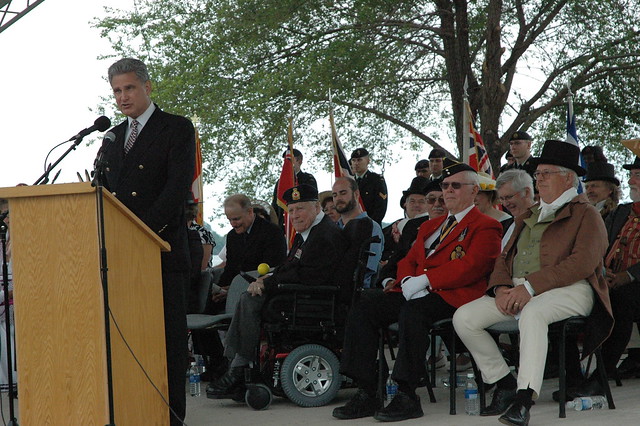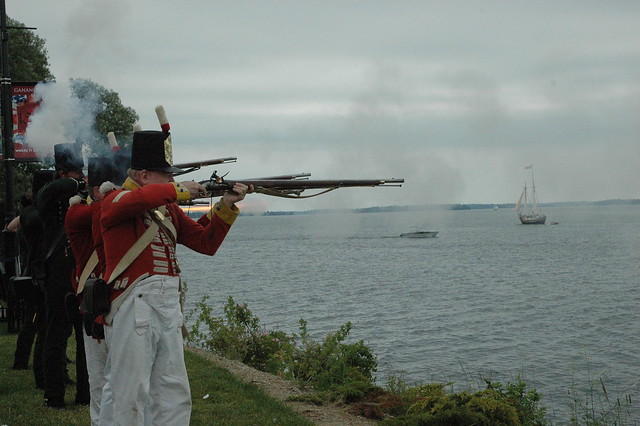20th June 2012 Ottawa, Canada
Remembering the “forgotten war”
War fever is racing down the river! Actually, war commemoration fever, as the many ceremonies to mark the War of 1812 begin.
I had the pleasure of attending two fascinating events in the last week. The first, at Ottawa’s excellent War Museum, is called: 1812: One War, Four Perspectives. Its curator is Dr Peter MacLeod, and there are some striking artefacts – a charred piece of the White House, courtesy HM Forces, 1814; a rather lugubrious British lion liberated from the ashes of York, courtesy US Forces, 1814; and what’s left of the battle ensign of the USS Chesapeake, courtesy of HMS Shannon, 1813. It’s an excellent exhibition and concept, showing the interlocking – but at times parallel, yet always vivid – perspectives of all sides (British, American, Canadian, First Nations), and many individuals. And it gives detail and depth to actions and encounters, not to mention people important to the fate of Canada, who’ve long been unjustly neglected.
Just as vivid was to see how historic Canadian towns are bringing their history to life. I was in Gananoque, on the banks of the St Lawrence, on 18 June – 200 years to the day that the US Congress declared war on Great Britain. The folk of Gananoque gathered in their hundreds in the new and impressive Col. Joel Stone Heritage Park to mark the event, and the US raids on the town in 1812.

Dignitaries included Gord Brown MP, Steve Clark MPP, Mayor Erika Demchuk (giving Laura Secord a run for her shilling in immaculate period costume), Mohawk Chief Stewart Deline (who was accompanied by First Nation drummers and singers in traditional garb, representing the Iroquois Confederacy) and not least by John R Matheson, who chaired the committee that chose the maple leaf as Canada’s flag.
Period uniforms abounded – British regulars, the Glengarry Light Infantry, Jack Tar and modern naval uniform – and cruising offshore was a yare little schooner, to remind us all of the Navy’s role in proceedings. Cannon were fired, muskets discharged, a huge Maple Leaf raised on an 80 foot staff, ribbons cut and the Town Crier, resplendent in blue trim and a tricorn hat, declared the Park open in a voice that would stop traffic on the 401.

A good time was had by all, but four things struck me: while we were rightly commemorating the War, we were celebrating the peace, and its fruits – the Stars and Stripes were in the crowd, carried by welcome cousins from across the water, who’d stormed ashore armed only with their credit cards; the close and affectionate links between Canada and the UK, alive and well at all levels; the huge enthusiasm and effort by the people of Gananoque, many of whom privately had helped sponsor proceedings, and who, with malice towards none, were taking a lively pride in their heritage; and finally the thought that as the news ran up and down the river, 2012 is on the way to becoming a genuinely popular celebration of the so-called “forgotten war”.
I wish it well, and intend to continue enjoying the spirit and ingenuity of Canadian celebration. And there are still Tall Ships to come on 24-26 August!
Andrew
Dear Andrew, what a fantastic report ! Esp. for those who are interested in history – like me.After reading your report several times I felt myself as some kind of a time-traveller.You ´ve mentioned many facts about this war – which started in 1812. But – more remarkable to me – you gave this war NAMES of all sides who where involved : BRITISH, AMERICANS, CANADIANS,FIRST NATIONS. This is very important because it also means that behind those 4 NAMES were a lot of FACES of these people which have fought in this war.Even if it ´s only on a symbolic way. For these people deserve – in my opinion – RESPECT and DIGNITY.The result is in my way of thinking that it will remind those people, who are living today in 2012 also, of how PEACEFUL life can be.I.e. and according to yr. words: Gord Brown, MP, Steve Clark, MPP or MOHAWK (Indian tribe)Chief Stewart, a man who surely was drawing attention to the Iroquois Confederacy. In other words: Many of the Canadian aborigines.Finally, and for me is this the MOST IMPORTANT fact – that exactly such kind of (as so excellent described by you) ceremonies and celebrations are keeping this outstanding CANADIAN and BRITISH CLOSEST FRIENDSHIP ALIVE.So, if I would have had the chance to wrote a guest-blogg, I would surely choose and prefer the headline: ” Remembering the “forgotten peace””. BW + a happy weekend, Ingo-Steven Wais, Stuttgart/Cardiff